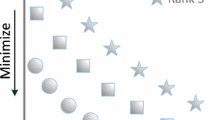Abstract
The series of non-dominated sorting based genetic algorithms (NSGA-series) has clearly shown their niche in solving multi- and many-objective optimization problems since mid-nineties. Of them, NSGA-III was designed to solve problems having three or more objectives efficiently. It is well established that with an increase in number of objectives, an increasingly large proportion of a random population stays non-dominated, thereby making only a few population members to remain dominated. Thus, in many-objective optimization problems, the need for a non-dominated sorting (NDS) procedure is questionable, except in early generations. In support of this argument, it can also be noted that most other popular evolutionary multi- and many-objective optimization algorithms do not use the NDS procedure. In this paper, we investigate the effect of NDS procedure on the performance of NSGA-III. From simulation results on two to 10-objective problems, it is observed that an elimination of the NDS procedure from NSGA-III must accompany a penalty boundary intersection (PBI) type niching method to indirectly emphasize best non-dominated solutions. Elimination of the NDS procedure from NSGA-III will open up a number of avenues for NSGA-III to be modified for different scenarios, such as, for parallel implementations, surrogate-assisted applications, and others, more easily.
Access this chapter
Tax calculation will be finalised at checkout
Purchases are for personal use only
Similar content being viewed by others
References
Binh, T.T., Korn, U.: MOBES: a multiobjective evolution strategy for constrained optimization problems. In: Proceedings of the Third International Conference on Genetic Algorithms (MENDEL 1997), pp. 176–182 (1997)
Blank, J., Deb, K.: Pymoo: multi-objective optimization in Python. IEEE Access 8, 89497–89509 (2020). https://doi.org/10.1109/access.2020.2990567
Blank, J., Deb, K., Dhebar, Y., Bandaru, S., Seada, H.: Generating well-spaced points on a unit simplex for evolutionary many-objective optimization. IEEE Trans. Evol. Comput. 25(1), 48–60 (2021). https://doi.org/10.1109/tevc.2020.2992387
Deb, K., Pratap, A., Agarwal, S., Meyarivan, T.: A fast and elitist multiobjective genetic algorithm: NSGA-II. IEEE Trans. Evol. Comput. 6(2), 182–197 (2002). https://doi.org/10.1109/4235.996017
Deb, K., Thiele, L., Laumanns, M., Zitzler, E.: Scalable multi-objective optimization test problems. In: Proceedings of the 2002 Congress on Evolutionary Computation (CEC 2002) (Cat. No.02TH8600), vol. 1, pp. 825–830. IEEE (2002). https://doi.org/10.1109/cec.2002.1007032
Deb, K.: Multi-Objective Optimization Using Evolutionary Algorithms. Wiley, London (2001)
Deb, K., Jain, H.: An evolutionary many-objective optimization algorithm using reference-point-based nondominated sorting approach, Part I: solving problems with box constraints. IEEE Trans. Evol. Comput. 18(4), 577–601 (2014). https://doi.org/10.1109/tevc.2013.2281535
Fonseca, C.M., Fleming, P.J.: Genetic algorithms for multiobjective optimization: formulation, discussion, and generalization. In: Proceedings of the Fifth International Conference on Genetic Algorithms, pp. 416–423. Morgan Kaufmann, San Mateo, CA (1993)
Horn, J., Nafpliotis, N., Goldberg, D.E.: A niched Pareto genetic algorithm for multiobjective optimization. In: Proceedings of the First IEEE Conference on Evolutionary Computation. IEEE World Congress on Computational Intelligence, pp. 82–87. IEEE (1994). https://doi.org/10.1109/icec.1994.350037
Huband, S., Barone, L., While, L., Hingston, P.: A scalable multi-objective test problem toolkit. In: Coello Coello, C.A., Hernández Aguirre, A., Zitzler, E. (eds.) EMO 2005. LNCS, vol. 3410, pp. 280–295. Springer, Heidelberg (2005). https://doi.org/10.1007/978-3-540-31880-4_20
Ishibuchi, H., Masuda, H., Tanigaki, Y., Nojima, Y.: Modified distance calculation in generational distance and inverted generational distance. In: Gaspar-Cunha, A., Henggeler Antunes, C., Coello, C.C. (eds.) EMO 2015. LNCS, vol. 9019, pp. 110–125. Springer, Cham (2015). https://doi.org/10.1007/978-3-319-15892-1_8
Jain, H., Deb, K.: An evolutionary many-objective optimization algorithm using reference-point based nondominated sorting approach, Part II: handling constraints and extending to an adaptive approach. IEEE Trans. Evol. Comput. 18(4), 602–622 (2014). https://doi.org/10.1109/tevc.2013.2281534
Kung, H.T., Luccio, F., Preparata, F.P.: On finding the maxima of a set of vectors. J. ACM 22(4), 469–476 (1975). https://doi.org/10.1145/321906.321910
Osyczka, A., Kundu, S.: A new method to solve generalized multicriteria optimization problems using the simple genetic algorithm. Struct. Optim. 10(2), 94–99 (1995). https://doi.org/10.1007/BF01743536
Srinivas, N., Deb, K.: Muiltiobjective optimization using nondominated sorting in genetic algorithms. Evol. Comput. 2(3), 221–248 (1994). https://doi.org/10.1162/evco.1994.2.3.221
Tanaka, M., Watanabe, H., Furukawa, Y., Tanino, T.: GA-based decision support system for multicriteria optimization. In: 1995 IEEE International Conference on Systems, Man and Cybernetics. Intelligent Systems for the 21st Century, vol. 2, pp. 1556–1561. IEEE (1995)
Zhang, Q., Li, H.: MOEA/d: a multiobjective evolutionary algorithm based on decomposition. IEEE Trans. Evol. Comput. 11(6), 712–731 (2007). https://doi.org/10.1109/tevc.2007.892759
Zitzler, E., Deb, K., Thiele, L.: Comparison of multiobjective evolutionary algorithms: empirical results. Evol. Comput. 8(2), 173–195 (2000). https://doi.org/10.1162/106365600568202
Acknowledgements
Authors acknowledge the financial support from Koenig Endowed Chair funding from the Department of Electrical and Computer Engineering at Michigan State University, East Lansing, USA.
Author information
Authors and Affiliations
Corresponding author
Editor information
Editors and Affiliations
Rights and permissions
Copyright information
© 2023 The Author(s), under exclusive license to Springer Nature Switzerland AG
About this paper
Cite this paper
Santoshkumar, B., Deb, K., Chen, L. (2023). Eliminating Non-dominated Sorting from NSGA-III. In: Emmerich, M., et al. Evolutionary Multi-Criterion Optimization. EMO 2023. Lecture Notes in Computer Science, vol 13970. Springer, Cham. https://doi.org/10.1007/978-3-031-27250-9_6
Download citation
DOI: https://doi.org/10.1007/978-3-031-27250-9_6
Published:
Publisher Name: Springer, Cham
Print ISBN: 978-3-031-27249-3
Online ISBN: 978-3-031-27250-9
eBook Packages: Computer ScienceComputer Science (R0)




